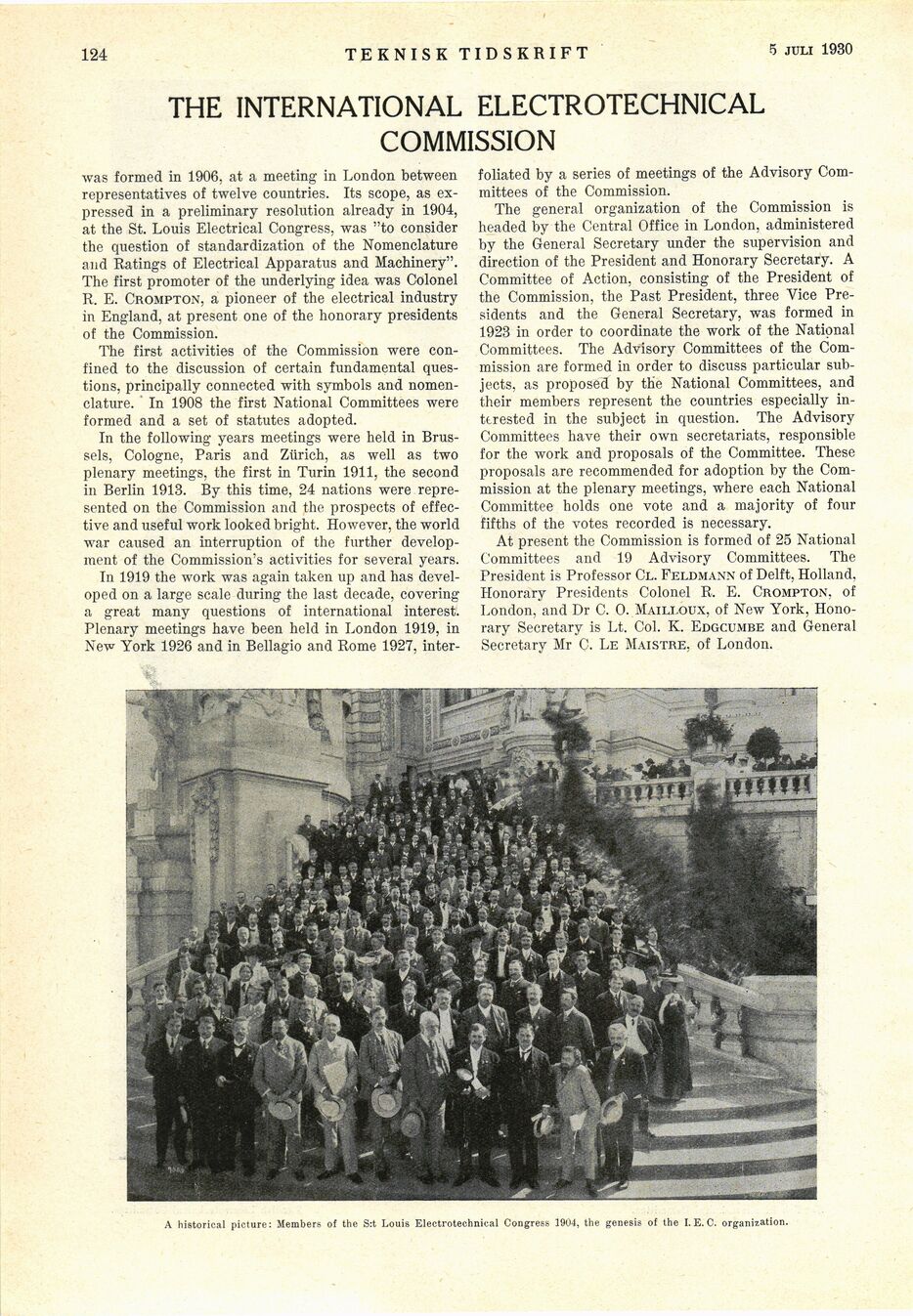
Full resolution (JPEG) - On this page / på denna sida - Sidor ...

<< prev. page << föreg. sida << >> nästa sida >> next page >>
Below is the raw OCR text
from the above scanned image.
Do you see an error? Proofread the page now!
Här nedan syns maskintolkade texten från faksimilbilden ovan.
Ser du något fel? Korrekturläs sidan nu!
This page has never been proofread. / Denna sida har aldrig korrekturlästs.
-124
teknisk tidskrift
1 febr. 1930
THE INTERNATIONAL ELECTROTECHNICAL
COMMISSION
was formed in 1906, at a meeting in London between
representatives of twelve countries. Its scope, as
expressed in a preliminary resolution already in 1904,
at the St. Louis Electrical Congress, was "to consider
the question of standardization of the Nomenclature
and Ratings of Electrical Apparatus and Machinery".
The first promoter of the underlying idea was Colonel
R. E. Crompton, a pioneer of the electrical industry
in England, at present one of the honorary presidents
of the Commission.
The first activities of the Commission were
confined to the discussion of certain fundamental
questions, principally connected with symbols and
nomenclature. In 1908 the first National Committees were
formed and a set of statutes adopted.
In the following years meetings were held in
Brussels, Cologne, Paris and Zürich, as well as two
plenary meetings, the first in Turin 1911, the second
in Berlin 1913. By this time, 24 nations were
represented on the Commission and the prospects of
effective and useful work looked bright. However, the world
war caused an interruption of the further
development of the Commission’s activities for several years.
In 1919 the work was again taken up and has
developed on a large scale during the last decade, covering
a great many questions of international interest.
Plenary meetings have been held in London 1919, in
New York 1926 and in Bellagio and Rome 1927, inter-
foliated by a series of meetings of the Advisory
Committees of the Commission.
The general organization of the Commission is
headed by the Central Office in London, administered
by the General Secretary under the supervision and
direction of the President and Honorary Secretary. A
Committee of Action, consisting of the President of
the Commission, the Past President, three Vice
Presidents and the General Secretary, was formed in
1923 in order to coordinate the work of the National
Committees. The Advisory Committees of the
Commission are formed in order to discuss particular
subjects, as proposed by the National Committees, and
their members represent the countries especially
interested in the subject in question. The Advisory
Committees have their own secretariats, responsible
for the work and proposals of the Committee. These
proposals are recommended for adoption by the
Commission at the plenary meetings, where each National
Committee holds one vote and a majority of four
fifths of the votes recorded is necessary.
At present the Commission is formed of 25 National
Committees and 19 Advisory Committees. The
President is Professor Cl. Feldmann of Delft, Holland.
Honorary Presidents Colonel R. E. Crompton, of
London, and Dr C. O. Maili.OUX, of New York,
Honorary Secretary is Lt. Col. K. Edgcumbe and General
Secretary Mr C- Le Maistre, of London.
A historical picture: Members of the S:t Louis Electrotechnieal Congress 1904, the genesis of the I. E. C. organization.
<< prev. page << föreg. sida << >> nästa sida >> next page >>